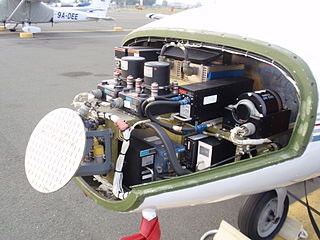Related Research Articles

Avionics are the electronic systems used on aircraft. Avionic systems include communications, navigation, the display and management of multiple systems, and the hundreds of systems that are fitted to aircraft to perform individual functions. These can be as simple as a searchlight for a police helicopter or as complicated as the tactical system for an airborne early warning platform.

In telecommunications, a transponder is a device that, upon receiving a signal, emits a different signal in response. The term is a blend of transmitter and responder.

A flight recorder is an electronic recording device placed in an aircraft for the purpose of facilitating the investigation of aviation accidents and incidents. The device may often be referred to as a "black box", an outdated name which has become a misnomer—they are now required to be painted bright orange, to aid in their recovery after accidents.
Aeronautical Radio, Incorporated (ARINC), established in 1929, was a major provider of transport communications and systems engineering solutions for eight industries: aviation, airports, defense, government, healthcare, networks, security, and transportation. ARINC had installed computer data networks in police cars and railroad cars and also maintains the standards for line-replaceable units.
In the U.S., Federal Communications Commission (FCC) regulations prohibit the use of mobile phones aboard aircraft in flight. Contrary to popular misconception, the Federal Aviation Administration (FAA) does not actually prohibit the use of personal electronic devices on aircraft. Paragraph (b)(5) of 14 CFR 91.21 leaves it up to the airlines to determine if devices can be used in flight, allowing use of "Any other portable electronic device that the operator of the aircraft has determined will not cause interference with the navigation or communication system of the aircraft on which it is to be used."

In aviation, ACARS is a digital datalink system for transmission of short messages between aircraft and ground stations via airband radio or satellite. The protocol was designed by ARINC and deployed in 1978, using the Telex format. More ACARS radio stations were added subsequently by SITA.

Inmarsat is a British satellite telecommunications company, offering global mobile services. It provides telephone and data services to users worldwide, via portable or mobile terminals which communicate with ground stations through fourteen geostationary telecommunications satellites. Inmarsat's network provides communications services to a range of governments, aid agencies, media outlets and businesses with a need to communicate in remote regions or where there is no reliable terrestrial network. The company was listed on the London Stock Exchange until it was acquired by Connect Bidco, a consortium consisting of Apax Partners, Warburg Pincus, the CPP Investment Board and the Ontario Teachers' Pension Plan, in December 2019.

The DRDO Airborne Early Warning and Control System (AEW&CS) is a project of India's Defence Research and Development Organisation to develop an airborne early warning and control system for the Indian Air Force. It is also referred to as NETRA Airborne Early Warning and Control System (AEW&CS).

Automatic Dependent Surveillance–Broadcast (ADS-B) is a surveillance technology and form of Electronic Conspicuity in which an aircraft determines its position via satellite navigation or other sensors and periodically broadcasts it, enabling it to be tracked. The information can be received by air traffic control ground stations as a replacement for secondary surveillance radar, as no interrogation signal is needed from the ground. It can also be transmitted and received point-to-point by other aircraft to provide situational awareness and allow self-separation. ADS-B is "automatic" in that it requires no pilot or external input. It is "dependent" in that it depends on data from the aircraft's navigation system.
WSPR is an acronym for Weak Signal Propagation Reporter. It is a protocol, implemented in a computer program, used for weak-signal radio communication between amateur radio operators. The protocol was designed, and a program written initially, by Joe Taylor, K1JT. The software code is now open source and is developed by a small team. The program is designed for sending and receiving low-power transmissions to test propagation paths on the MF and HF bands.
SwiftBroadband is an IP-based packet-switched communications network that provides a symmetric ‘always-on’ data connection of up to 650 kbit/s per channel for aircraft globally except for the polar regions, using the Inmarsat satellite constellation.

The following lists events from 2014 in Malaysia.

Malaysia Airlines Flight 370 (MH370/MAS370) was an international passenger flight operated by Malaysia Airlines that disappeared on 8 March 2014 while flying from Kuala Lumpur International Airport in Malaysia to its planned destination, Beijing Capital International Airport. The crew of the Boeing 777-200ER registered as 9M-MRO, last communicated with air traffic control (ATC) around 38 minutes after takeoff when the flight was over the South China Sea. The aircraft was lost from ATC radar screens minutes later, but was tracked by military radar for another hour, deviating westward from its planned flight path, crossing the Malay Peninsula and Andaman Sea. It left radar range 200 nautical miles northwest of Penang Island in northwestern Peninsular Malaysia.

Flightradar24 is a Swedish internet-based service that shows real-time aircraft flight tracking information on a map. It includes flight tracking information, origins and destinations, flight numbers, aircraft types, positions, altitudes, headings and speeds. It can also show time-lapse replays of previous tracks and historical flight data by airline, aircraft, aircraft type, area, or airport. It aggregates data from multiple sources, but, outside of the United States, mostly from crowdsourced information gathering by volunteers with ADS-B receivers and from satellite-based ADS-B receivers.
Malaysia Airlines Flight 370 disappeared on 8 March 2014, after departing from Kuala Lumpur for Beijing, with 227 passengers and 12 crew members on board. Malaysia's former Prime Minister, Najib Razak, stated that the aircraft's flight ended somewhere in the Indian Ocean, but no further explanation had been given. Despite searches finding debris considered with strong certainty to originate from the crash, official announcements were questioned by many critics, and several theories about the disappearance were proposed. Some of these theories were described as conspiracy theories.
The Joint Agency Coordination Centre (JACC) is an Australian government agency which was established on 30 March 2014 to coordinate search and recovery operations for Malaysia Airlines Flight 370, which disappeared on 8 March 2014 and was soon thereafter determined to have ended in the Southern Indian Ocean, within Australia's concurrent aeronautical and maritime search and rescue regions. The JACC is an agency within Australia's Department of Infrastructure and Regional Development, headed by Judith Zielke. It does not perform any search, recovery, or investigation activities, but coordinates the search effort and serves as a primary point of contact for information about the search for media and families of Flight 370 passengers.
The Boeing Uninterruptible Autopilot is a system designed to take control of a commercial aircraft away from the pilot or flight crew in the event of a hijacking.

The disappearance on 8 March 2014 of Malaysia Airlines Flight 370, a scheduled international passenger flight from Kuala Lumpur International Airport to Beijing Capital International Airport, prompted a large, multinational search in Asia and the southern Indian Ocean that became the most expensive search in aviation history. Analysis of communications between the aircraft and Inmarsat by multiple agencies has concluded that the flight ended in the southern Indian Ocean.

The analysis of communications between Malaysia Airlines Flight 370 and Inmarsat's satellite telecommunication network provide the primary source of information about Flight 370's location and possible in-flight events after it disappeared from military radar coverage at 2:22 Malaysia Standard Time (MYT) on 8 March 2014, one hour after communication with air traffic control ended and the aircraft departed from its planned flight path while over the South China Sea.

The timeline of Malaysia Airlines Flight 370 lists events associated with the disappearance of Malaysia Airlines Flight 370—a scheduled, commercial flight operated by Malaysia Airlines from Kuala Lumpur International Airport to Beijing Capital International Airport on 8 March 2014 with 227 passengers and 12 crew. Air traffic control lost contact with Flight 370 less than an hour into the flight, after which it was tracked by military radar crossing the Malay Peninsula and was last located over the Andaman Sea. Analysis of automated communications between the aircraft and a satellite communications network has determined that the aircraft flew into the southern Indian Ocean, before communication ended shortly after 08:19 (UTC+8:00). The disappearance initiated a multi-national search effort that became the most expensive search in aviation history.
References
- 1 2 3 A330 TECHNICAL TRAINING MANUAL MECHANICAL & AVIONICS COURSE, pages 58 - 69, copyright Airbus S.A.S, published before 2014, but copyright date not given
- ↑ www.radio-electronics.com http://www.radio-electronics.com/articles/satellite-technology/satellite-backhaul-for-in-flight-connectivity-for-85 . Retrieved 1 July 2014.
{{cite web}}: Missing or empty|title=(help) - ↑ www.cobhamsb200.com http://www.cobhamsb200.com/SDU7310.aspx . Retrieved 1 July 2014.
{{cite web}}: Missing or empty|title=(help) - ↑ "Information provided to MH370 by AAIB: Information provided to MH370 investigation by UK Air Accidents Investigation Branch (AAIB)". Department of Civil Aviation Malaysia. Retrieved 6 May 2014.